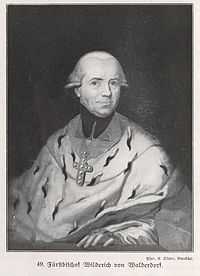Wilderich of Walderdorf

Philipp Franz Wilderich Nepomuk (2 March 1739 – 21 April 1810) was count of Walderdorf and the last prince-bishop of Speyer.
His reign was short, from 1797 until the secularization in 1803. In was unusual that during the secularization, Wilderich was able to live in the south wing of his official residence, the baroque palace in Bruchsal, until his death in 1810. When he was inaugurated in his office, there were already signs indicating that the dissolution of the old empire was at hand. On 22 April 1797, following the death of his predecessor August Philip of Limburg Stirum, Walderich, who was at that time the Domdechant of Trier, was installed as lord bishop of Speyer.
Wilderich left few physical traces of construction in the Bruchsal palace. It was the little room north of the Fürstensaal, which the newly appointed bishop immediately arranged for his regency. The stuccoers had to use all their imagination and Walderich did not exactly make it easy for them. It was less the artistic design of space as much as the willfullness of the presentation, which Wilderich demanded. More so it was with the furniture with which they had to decorate the room.
At the beginning of the year 1799, the French came across the Rhine. In the Treaty of Lunéville Napoleon had initiated the secularization. The Peace of Luneville was confirmed by the Reichstag of Emperor Franz on 9 February 1801. Prince-bishop Wilderich had to flee. Yet he returned on 10 June 1801 to his seat. Then a "Deputation" used to implement the terms of the accord as agreed. Above all, it was the dissolution of the ecclisiastical offices that had to be implemented. The episcopal holdings, the cathedral chapter and secular holdings, were given to the newly created Principality of Bruchsal, now part of Baden. The principality took over secular control on 1 December 1802 and began to create an administration. The Bruchsal palace became the property of Baden. Prince-bishop Walderich retained his princely title as guaranteed by the state. The southern half of the palace remained available to him, as well as the Hermitage in Waghäusel. Amalie Christiane of Baden moved into the northern part of the palace in her widowhood and finally gave the palace Bruchsal its courtly splendor.
Sources
- Translated and edited from de:Philipp Franz Wilderich Nepomuk von Walderdorf, 10 Dec 2008